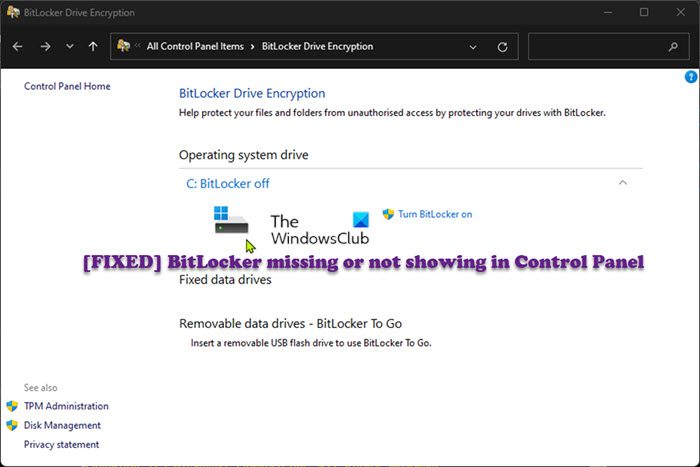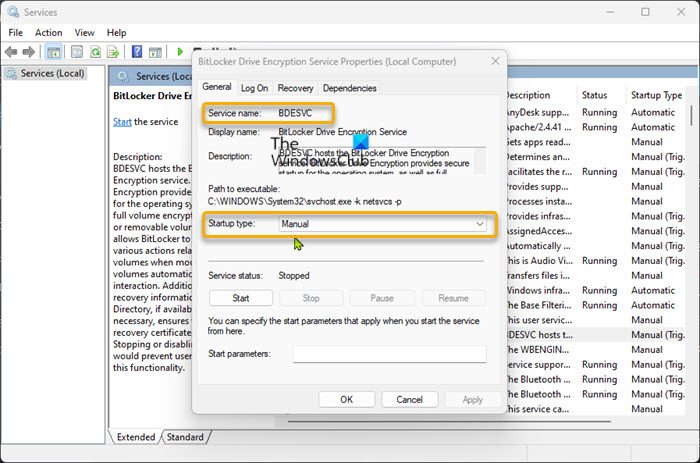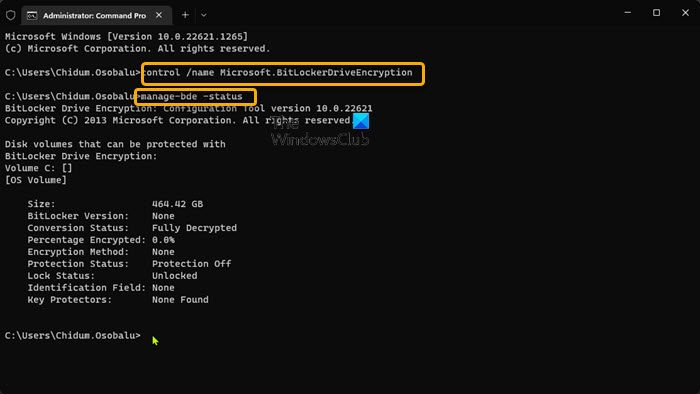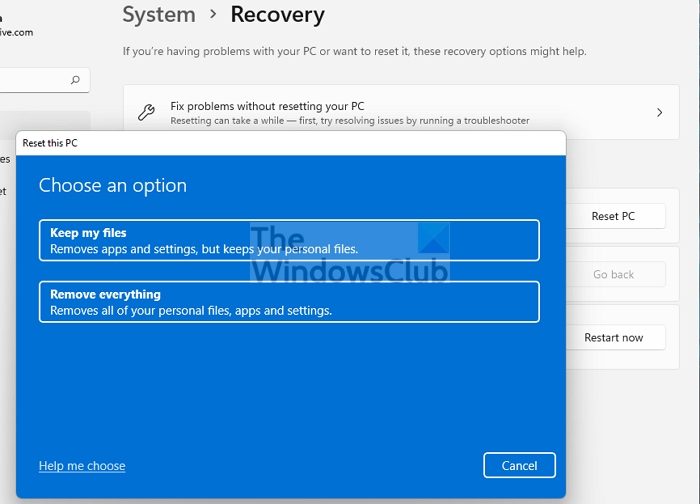BitLocker is a device encryptor feature native to the Windows operating system, that allows PC users to protect data from theft or getting exposed to lost, stolen, or inappropriately decommissioned systems. This post is intended to help you resolve the issue when BitLocker is missing or not showing in the Control Panel in Windows 11/10.

BitLocker missing or not showing in Windows 11/10
It’s imperative to point out that Device encryption is different from BitLocker drive encryption. All Windows Home editions support only the former, whereas every other edition supports both security features. That said, to check if your computer supports either feature or not, you can open System Information (msinfo32.exe), then look for Device Encryption Support, and you will see why the feature is not available on your computer.
If, however, you check your installed Windows 11/10 edition and your OS edition is supported and your device meets the minimum hardware requirements for BitLocker, but BitLocker is missing or not showing in the Control Panel too, then the following suggestions we have provided below can help you to resolve the issue on your system.
- Check the BitLocker Drive Encryption Service
- Use Command Prompt to open BitLocker Control Panel applet
- Reset PC or In-place Upgrade Repair Windows 11/10
Let’s see these suggestions in detail. Before you proceed, make sure Windows is activated on your device if not already activated, as this might be the culprit to the issue.
1] Check the BitLocker Drive Encryption Service

The BitLocker Drive Encryption Service (BDESVC) allows BitLocker to prompt users for various actions related to their volumes when mounted and unlocks volumes automatically without user interaction. Additionally, it stores recovery information in Active Directory, if available, and, if necessary, ensures the most recent recovery certificates are used. Stopping or disabling the service would prevent users from leveraging this functionality.
The first action you can take if your PC meets the operating system as well as hardware requirements, but BitLocker is missing or not showing for your device, is to check the BitLocker Drive Encryption Service and make sure the service is set to Manual (Trigger Start) which is the default Startup type. You can run the command below in the elevated Command Prompt to restore the default startup configuration of the BitLocker Drive Encryption Service.
sc config BDESVC start= demand
Once the command executes exit the CMD prompt and restart your PC.
Read: Enforce BitLocker drive encryption for removable data drives
2] Use Command Prompt to open BitLocker Control Panel applet

Other things being equal, including making sure your PC hardware and OS are supported, you can access the BitLocker Drive Encryption Control Panel applet by running the command below in Command Prompt or the Run dialog box.
control /name Microsoft.BitLockerDriveEncryption
If the command executes but doesn’t open BitLocker Drive Encryption, then you can try running the command below from an elevated command prompt.
manage-bde -status
The manage-bde command is one of the commands of the BitLocker Drive Encryption tool in the Command prompt that PC users can use to check BitLocker drive encryption status in Windows 11/10.
Read: Change how BitLocker unlocks OS Drive at Startup
3] Reset PC or In-place Upgrade Repair Windows 11/10

If the suggestions above didn’t solve the problem for you, there might be something wrong with the system. In this case, you can reset the PC, perform an in-place upgrade repair, or worst-case scenario, you can clean install Windows 11/10 to recover or restore the BitLocker feature. Suppose your Windows edition doesn’t support BitLocker. In that case, the only way out to take advantage of this feature is to upgrade to a Windows edition that supports BitLocker, running on supported or required hardware.
I hope this helps you!
Related post: Device Encryption not showing or working in Windows
Does Windows 11 enable BitLocker by default?
By default, BitLocker is enabled on all Windows 11 PCs. Once the drive is encrypted with BitLocker, Windows asks where you’d like to back up the encryption key. The key reduces the odds of the data being tampered with, should your laptop get stolen or lost. While BitLocker is not available for the Home edition, Windows 11 still provide device encryption in specific devices, such as Surface Pro 9, Laptop 5, and others.
Read: How to find BitLocker Recovery Key with Key ID in Windows 11
How do I enable BitLocker in Windows 11 without TPM?
BitLocker can encrypt your system drive even without a TPM chip. However, for this to work, you need to edit a Windows policy using the Local Group Policy Editor tool. The step-by-step instructions to carry out this task is provided in the guide on how to turn on BitLocker for Windows System Drives without TPM.